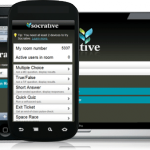 Last week I was reading about a new whiteboard service called SMART kapp, which connects up a whiteboard with recipients mobile devices. It enables whatever is written onto the whiteboard (using standard pens) to be sent either recorded or live to any number of mobile users.
Last week I was reading about a new whiteboard service called SMART kapp, which connects up a whiteboard with recipients mobile devices. It enables whatever is written onto the whiteboard (using standard pens) to be sent either recorded or live to any number of mobile users.
At the end of each session, whatever went onto the whiteboard is converted into either a PDF or JPG file and sent off to the distribution list.
It’s quite a neat way of distributing content to a wide audience. The product was initially pitched to business users for use in meeting rooms, but I think a better application would be in the classroom.
The theory is that students are increasingly turning to mobile devices in the classroom, so you may as well make use of them for something productive.
A similar line of thinking led to the creation of Socrative, a new mobile app that allows teachers to design quizzes for students to take during a class.
The app has already proven hugely popular, with around 1.1 million teachers and millions of students using it around the world.
It was the brainchild of Amit Maimon whilst working as a teaching assistant at MIT. The theory is that as they’re already zoomed into their mobile device, a quiz delivered there is more likely to obtain their attention.
What’s more, the digital quizzes are automatically fed to the teacher, who can thus get instant feedback on understanding levels amongst their class.
“Teachers benefit tremendously by having knowledge of what their students find easy or difficult, what they’re understanding or not, in the moment, in class,” Maimon says. “Teachers [with Socrative] can see how well the class is doing in a very detailed way, and see who’s struggling more, what the class doesn’t understand, and even which students can help others.”
The quizzes are easy to setup and come in a variety of forms, including multiple choice, open ended questions, true or false, and so on. Students access their quizzes by entering their class ID number and off they go.
This real time data on student progress is especially powerful, with the anonymous response option especially potent in securing participation from students.
“That’s when the power of real-time anonymity came in, which is fantastic because it changes the social layout,” the developers say. “If you’re afraid of asking a question because you think you’re the only one who doesn’t understand it, and then suddenly you remove that barrier, you see many others don’t understand as well, and it changes people’s comfort levels.”
It’s great to see innovations like this hitting the classroom. Long may it continue.
I could see that in a university but not in a secondary school.